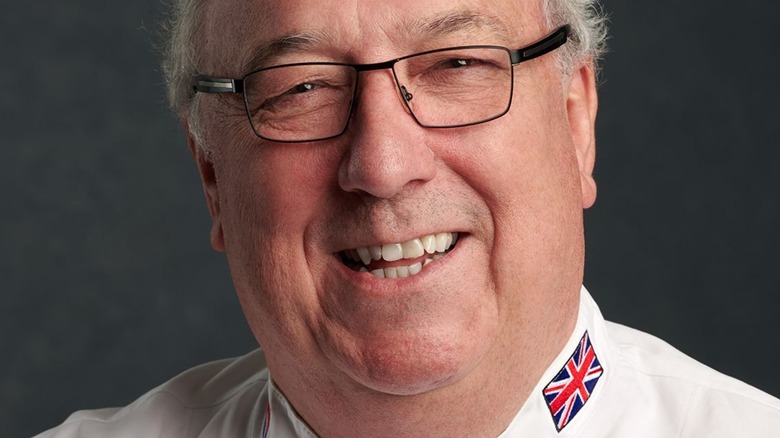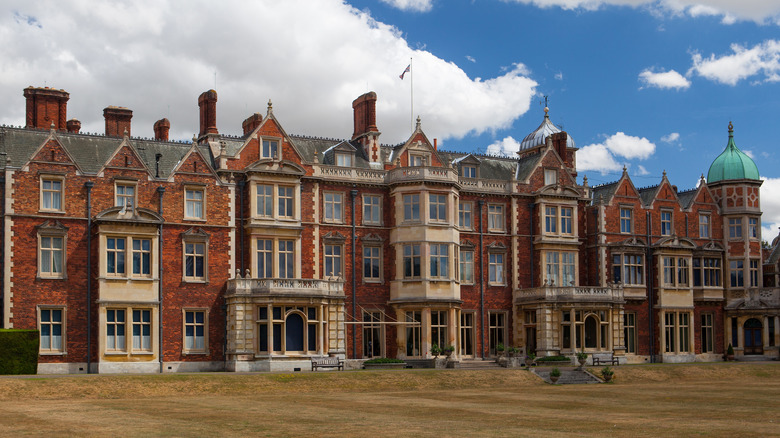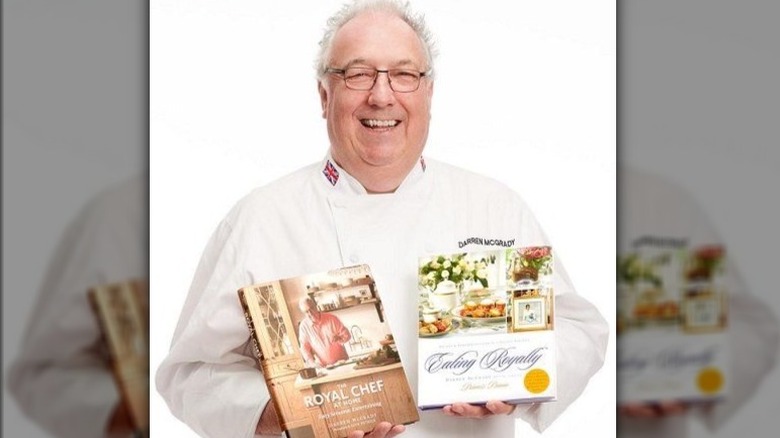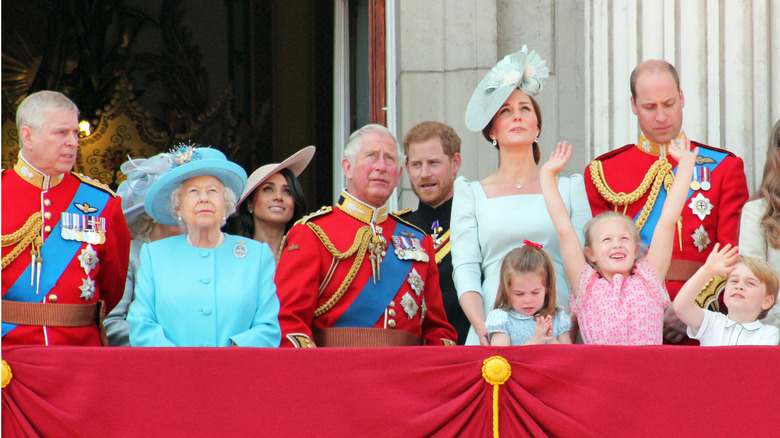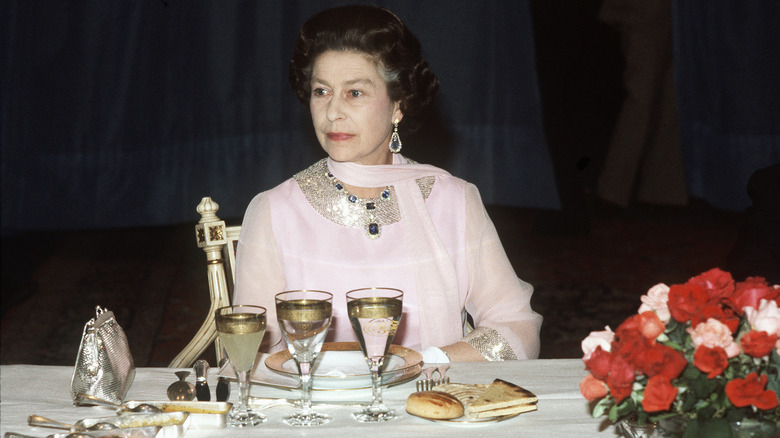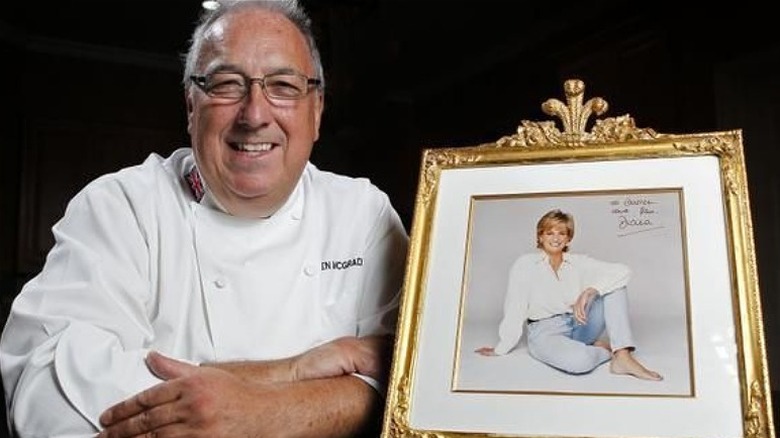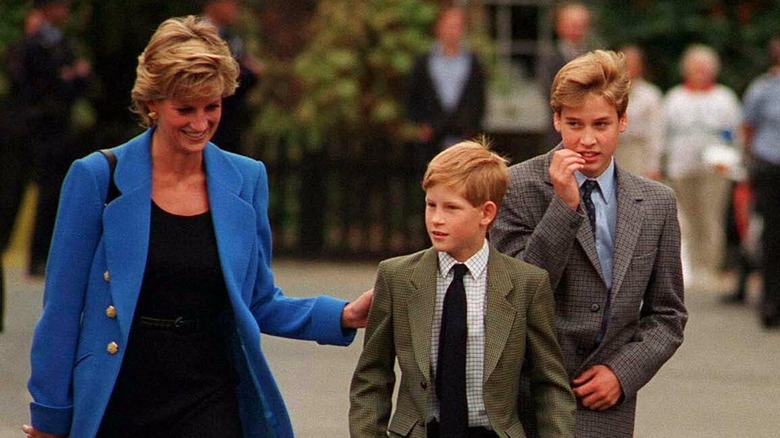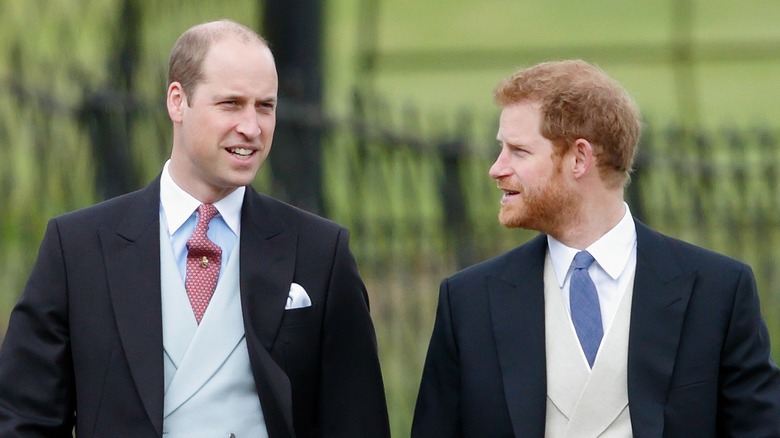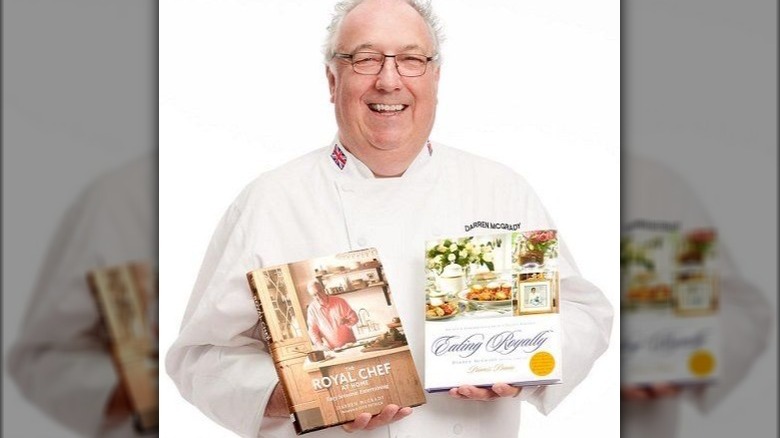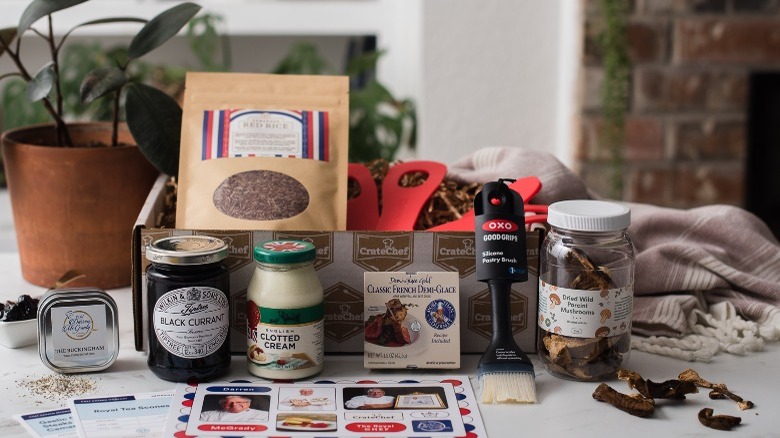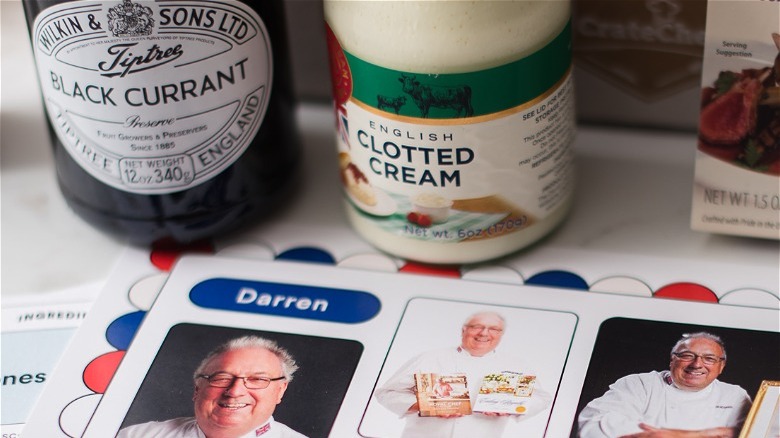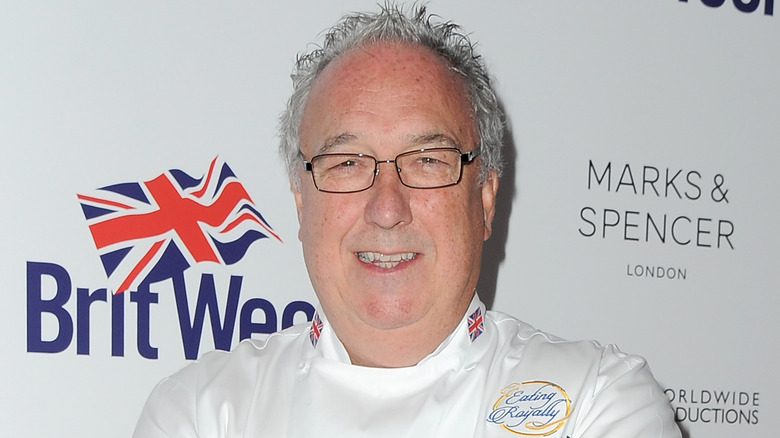Chef Darren McGrady Dishes On Cooking For Princess Diana And The Queen - Exclusive Interview
Darren McGrady, thank you for asking, spent 15 years baking chocolate cakes and Tarte Tatins, and cooking up roast beef lunches and slow-braised lamb in the employ of the royal family. First, he was a live-in chef at Buckingham Palace, and then moved on to work for Princess Diana. Despite its grim portrayal in "Spencer," McGrady's favorite royal residence to cook at was Sandringham. There, amid ghosts (yes ghosts!) and Christmas festivities, he chatted with Prince Philip, Prince Charles, Princess Diana, Princess Margaret, and, yes, even the queen, as they wandered into the kitchen, stir crazy from being "stuck there" over the holidays. More than that, McGrady's time at Sandringham marked the royal chef's "favorite time of the year." It was, after all, during the winter months that McGrady would cook up his preferred royals recipes — dishes McGrady revealed "would sort of line your insides and keep you warm."
This month, if you have a CrateChef subscription, you'll receive a box Chef McGrady put together, full of ingredients fit for a royal palate. To celebrate, he sat down with Mashed and dished, among other things, on his favorite Sandringham memories, Princess Diana's dedication to juicing and the true trick to mastering the macaroni and cheese that Prince Harry and William loved as kids. (Sorry, Gordon Ramsay. Chef McGrady's gave us the green light to use truffle oil on this one!)
Darren McGrady shares his experience with the ghosts of Sandringham
You lived at Buckingham Palace while you worked there. Can you tell me a Buckingham Palace ghost story?
Not really. I never saw any ghosts at Buckingham Palace. I didn't. I heard of a few stories. But Sandringham, for me, was the most haunted, where the Royal family go at Christmas. And that one, I know. I remember hearing a story. Actually, I was working in the kitchen. The kitchen is next door to the royal dining room, but also next door to the old library, which is part of the old building of Sandringham. I remember being there, and it was about 6:00 at night, getting dark. The footman, his job was to actually walk through the old library. And it was always sort of damp and musty, and it was old. He walked through there, and his job was to lift the drapes, which were sort of like this, and tied with a sash.
He would actually unhook them [and] pull the drapes together. They were in bay windows. So he would pull the drapes across and then hook the hooks back up again — the gold hooks. He was in there one day, and he pulled the drapes and moved onto the next one. And this hand came from behind the drapes and actually hooked the little tie back onto the hook. And he looked, and he thought, "Okay, someone's messing with me." So he went back there and yanked the drapes open. And no one was there! And he went screaming, and that's what we heard in the kitchen. He went screaming out into the butler's pantry ... And he actually took the [queen's] dogs in there. And the dogs were barking in the library. So it was like, "Oh, my gosh"
Cooking for the royal family during Christmas at Sandringham
You watched "Spencer." In your review of it, you mentioned that Sandringham was your favorite palace to cook. Can you share some of your Sandringham memories?
Sandringham really was. Windsor Castle was so big. We never saw the royal family at all, just for Christmas. When we were there, it was great. Windsor was fantastic. We used to go to Windsor before the fire, the great fire, the annus horribilis year. And that was fun. We'd be walking in the Windsor wonderland as the chefs would say. But when we went to Sandringham, it was much tighter, much smaller. And the princess [in "Spencer"] talks about it being claustrophobic and everything there. It is a much smaller house. It's Sandringham house. It's not a castle. And so, we were actually right next door. I could hear Princess Diana laughing in the dining room across from the kitchen.
It was much smaller. And I think that's just one of the reasons. Everybody was happy. Everybody was on a high. It was so much fun. Christmas Eve, all of the food arriving from all the purveyors and everybody getting into that holiday mode. And of course, the royals were just bored for a lot of the time. They were all stuck there. So they would just wander in the kitchen. Every minute, there was someone coming in, whether it was Prince Philip coming to see what Harrods had sent in the Christmas hamper that they gifted; whether it was the Prince of Wales coming to see that is organic foods had come up from Highgrove; or whether it was just Princess Diana wanting a chat; or even the queen and Princess Margaret. I remember them coming into the kitchen at Sandringham, too. So they did wander into the kitchen quite a lot.
And then also [at] Sandringham I was resident DJ for the social club. At the end of the evening, Christmas Eve, as soon as royal dessert had gone into the dining room, I raced down, showered, changed in there, and started spinning the discs. One year, we actually had Princess Diana and Lady Sarah Armstrong Jones — that's Princess Margaret's daughter — come down. This was a Royal command performance for me, spinning the discs. And they stayed a little while. They danced, and then they left. But it was a fun time at Sandringham, the interaction with the royals there.
Darren McGrady dishes on the royal family's winter eating habits
Sandringham is tied to Christmas and the winter holidays. What were the royal family's favorite cold-weather meals?
Obviously, dishes like Eton mess and all the strawberry dishes and things were off the menu, come the holidays. But it was a great time. It was a great time of the year for us. And it's still my favorite time of the year in the kitchen, when we move out of that sort of summer cooking into the long, slow cooking, the long slow braises. To put a leg of lamb in the oven and just slow braise it till it just all falls apart, and to serve that with the parsnip mashed potatoes. It's just delicious, the smell of the long slow braises cooking in the kitchen. So it was much, much heartier food. It was lots of vegetables, the winter vegetables, all the vegetables that were grown under the ground, that we served more at Sandringham.
And then desserts, there was a lot of apples on the menu, and pears. Because [they were] not only in season, but Sandringham also had a fruit farm that was started by King George, the queen's father, King George the Sixth. And so, we'd actually get some incredible apples come up. So dishes like the Tarte Tatin that I did on my YouTube channel, I think that used to appear on there quite a lot, as well as the bread and butter pudding and the crêpe soufflé that they talk about Princess Diana [loving] in the movie.
Does the queen have any cheat days?
The amazing thing is the queen's 5-foot-two and hardly weighs anything. And she actually, she'd eat four meals a day when I was there, breakfast, lunch, afternoon, tea, and dinner. And it was never really ... The only time that she gave things up was actually for religious reasons. For Lent, and she'd give up chocolate. But other than that, she never gave anything up at all. And so, she would eat all the rich foods and things, but it was in small portions. And it was discipline. She could have a tiny portion of something, and that was fine. The chocolate cakes that we sent up for afternoon tea, I mean, for me, I would say, "Yes, just leave it on the side. I might have another slice later." But for the queen, that one slice – or ginger cake — just one little slice, back to the kitchen, and that's fine. It was discipline more than anything with the queen, eating four meals a day and just smaller portions and being disciplined.
What Spencer gets wrong about royal cuisine
What was one thing that could never be missing from your fridge?
One of the strangest things, I would probably say cream. We see in the "Spencer" the movie, there's so much food. And in "Spencer," the movie, there's far too much food. As I said in my review, all of that food was just the antithesis of the bulimia to the princess, that there's so much food — "And I want the food, and I need to eat the food." It wasn't really like that. [The food in the movie] was enough food for a cruise ship.
But most of the dishes [we cooked for the royal family] were heavy, traditional French cuisine dishes that were heavily laden with lots and lots of cream. After that, I'd say the Christmas puddings. The Christmas puddings, the traditional English Christmas puddings that we would make before we went off to Balmoral. We'd make them in the summer and give them chance to rest and ripen up and then take them up to Sandringham, where we'd actually have them ready for Christmas Day, for New Year's Day, where we steamed the puddings and did a brandy sauce. And we'd make the mincemeat too.
So making all the mincemeat into the little puff pastry tartlets that they'd take out to the hills. When they were shooting, they'd stop and have lunch. And they'd pop the lid off the pastry, and we'd make some brandy butter that they would put inside and then put the lid back on. And the brandy butter melted into the little mincemeat tartlets. And so, you pop them in your mouth and all that brandy butter runs down your chin. Gorgeous.
But Sandringham, there's lots of shooting going on, shooting lunches, lots of pheasant on the estate. Shooting lunches were super popular. And, of course, that meant we'd send out food that would clog your pipes, as we say in England, sort of line your insides and keep you warm. So steak and kidney puddings, traditional British foods and things like that. That would be really popular too. And lots of mashed vegetables.
Darren McGrady shares what it was like cooking for Princess Diana
How did your day-to-day change when you left Buckingham and started working for Princess Diana?
When I joined the princess, her meals changed. The cream virtually disappeared. It was the healthy eating dishes then. And so, she'd got her life back on track and was eating healthy.
Food was part of that journey for her, she began to be more conscious of what she was putting into her body.
Yeah. It was, I mean, obviously with the bulimia and everything, that was different. But when I joined her, she said, "You take care of all the fat. I'll take care of the carbs at the gym." And she did. She was eating healthy. She was working out three days a week. And she said, "What's this got in it? What's this?" And she loved me coming out with new ideas. And of course, she studied juicing as well. She was juicing before, I think, anybody had even heard of it.
What was Princess Diana juicing?
Juicing was a combination. Different ones. A friend would tell her, "Oh, you need to juice this, because this is this." Obviously, we didn't have the internet then or anything, where she could Google things, fortunately. It would've been crazy! But she would come in the kitchen and say, "Beets. I need beets. Let's juice beets, because they're super good for your skin. They're good for digestion and diuretics. And so, do beets." And I'd say, "Your Royal Highness, you can't just have beets, because you've got to blend it. It's too rich. You got to do apple or celery, carrot. Which do you want?" She says, "No, just do me a big glass of beets."
I did beets for one day, and it was the day before Trouping, and she tried this drink. She came in an hour later, and her face was all blotchy. I think it was a reaction to the beets. And she said, "You poisoned me." I said, "It's the beet juice." So she drank loads of water. And then she was fine after that. But after then, we'd start mixing it with apple juice. So she had the beet and apple juice.
The foods Harry and William wouldn't touch growing up
Do you have memories of Harry and William in the kitchen when they were kids?
They love cooking now. They didn't love cooking at the time. They were royal children, but they were still children. They didn't really enjoy being in the kitchen other than coming through to either ask what was for dinner or to play hide and seek, because it was raining outside. So William or Harry would come and hide in the kitchen.
I never actually did cooking lessons for the boys. They came in the kitchen, they'd hang around. "What are you cooking?" And ask that. It would be fun to sort of talk about them while I'm roasting chicken. And how does that work? And so, they'd come in the kitchen and look and taste, try this – "What do you think?" But watching them grow up and everything, they didn't cook in the kitchen at all.
Was there anything that William and Harry would not touch on the dinner table, growing up?
Absolutely. Yeah. Green vegetables. They were royal princes with children's palettes. So no, no green vegetables. But the boys, if they could have things like cottage pie and corn, then they were happy. If they could have pizza, fried chicken, or something, they were happy. French fries, yes, please. Burgers, love them. Yes, please. But of course, there was a constant battle.
When the princess was at home and the boys were there, she would eat in the dining room with the boys. And Nanny Olga would actually be sent down into the staff dining room, and she would complain, "I bet she's letting those boys have hamburgers. They should be eating their greens and their vegetables." Whenever the princess was on an engagement for lunch, Olga would always make sure, "I want you to do plenty of cabbage, greens, broccoli, everything. I want all of those on the plate." So, it was a constant battle between the nanny and the princess.
Chef Darren McGrady reveals how to cook Harry and William's favorite mac and cheese
Harry and William loved mac and cheese growing up. You've shared your recipe for their mac and cheese. What do you think most people get wrong when they try to make mac and cheese at home?
The main thing that people get wrong, making mac and cheese at home, is going into the pantry and picking out a box. That's what they get wrong. Stop. Throw those boxes away. That synthetic nasty cheese is awful. Back in the olden days, it had E102 tartrazine in there. That is a carcinogen. That is evil and nasty. We don't want that in there. Nowadays, they do tend to put turmeric in there. So it's a bit healthier. But to make a cheese sauce is not really, really hard. It's not.
In the kitchen, we're chefs, we're cooks. And we're not magicians. If we were magicians, we'd be on the stage. So, I can't put a tatty old piece of skirt steak in the oven and pull out a beef tenderloin. We can't do that. But if you give me a beef tenderloin, a filet of beef, I can create something amazing with it. And it's the same with a cheese sauce. If you can just get a little chunk of fresh parmesan, maybe a little gruyere, and then some beautiful mature cheddar, then make your own sauce. It's not hard to make: a little butter, a little flour, stir it, add your milk, and then grate that cheese. And then just let that cook.
When you're making your cheese sauce, let that sauce just bubble away for 20 minutes. That's how long it takes to open those starch granules in the sauce. And that will make you the shiniest, most gorgeous sauce. Drop in your macaroni then, give it a stir. Into the bowl, a sprinkle more of Gruyere or Parmesan on top. If you want, some toasted breadcrumbs, a little splash of truffle oil. Forget what Gordon Ramsay says. We love truffle oil. Add a splash of that in there. We can't afford fresh truffles at home. We're not all as rich as him. A little splash of truffle oil, stirred in, into the oven. That comes out amazing.
Here in Texas, one of our most popular dishes on the Eating Royally menu, we actually smoke pork, and we pull the smoked pork, hickory-smoked pork. Fold that into the mac and cheese. It is unbelievable.
What it takes to be a chef at Buckingham Palace, according to Darren McGrady
You worked at Buckingham Palace for 11 years. Were you ever involved in hiring other chefs? What does it take to be a chef for the royal family?
Yeah, no, I wasn't involved in hiring the chefs. That was the job of the assistant to the master of the household F branch, F for food. We had food assistant to the master household G, which was general, the footman and assistant to the master household H, which is housekeeping. So that was his job. But I was surprised how easy it was to get a job there. I thought I'd probably have to get five or six interviews. Actually, first, maybe I cook for him. Then, maybe I cook for their head chef at the time. Then, maybe I cook for one of the Royal family. Maybe. But no, I didn't cook for anyone.
I went for the interview. It's always the case of not what you know, but who you know. And the assistant to the master of the household F branch came originally from the Savoy group, Colonel Claridges and the Savoy. And he thought Savoy chefs were well trained, they had a background. I trained at the Savoy. I was just over two years at the Savoy, and he took me on.
I do think that when it comes to being a chef at the palace, 50% of actually becoming a chef there is your personality. Certainly in my days, because we had a very full nursery. We had William, Harry, Zara, Peter, Beatrice, Eugenie. All the children could come into the kitchen at any time. And if we had 20 Gordon Ramsays running around the kitchen, swearing and shouting, that wouldn't have worked. That would not have worked! So, I think, half of it is the personality, that you can get on, because you're living with the other chefs. You're in London for six weeks, you go off to Balmoral for eight weeks, you go to Sandringham for two weeks, and then to Windsor again. You're just living out of a suitcase. You've got to get on, personality-wise, with everyone.
And then, the training is ... You think that, "Okay, well maybe we put Massimo Bottura in the kitchen." Amazing chef, best chef in the world, but he still can't cook. He would still get complaints from the queen. Because when you are cooking for the royal family, it's not like it's your restaurant — I'm creating a dish, and I'm serving it my way. Doesn't work like that. You are cooking for the queen and her guests. So you have to prepare the food the way she likes it. And if that means no garlic in there, there's no garlic in there. There's no egos. There's no "Top Chef" saying, "No, it needs garlic. I'm putting it in there." That doesn't happen.
The royal goodies you'll find in Darren McGrady's Crate Chef box
You are sending out a Buckingham palace seasoning in your CrateChef box. What's the story behind that?
One of the items that we put in the box was the Buckingham Palace or my Buckingham seasoning. And it's my seasoning. I created it. I used to use it when I was at the palace. It's mainly to use on beef, and it goes really well with lamb too. But beef, it just takes it to the next level, with a combination of all the ingredients in there, little things like celery seeds and things. It just really enhance seasoning. And it is a seasoning. It's not a rub.
I live in Texas now, and they slather these rubs over everything. And it's not that. It is actually a seasoning. So I created ... I do events all around the country, speaking events, and cooking classes. And people say, "What do you season? What's the best seasoning? How do you season fish? How do you season?"
So I thought, "Okay, well, I need to come out with my range." And thought, "Well, what should I call them? Why not the three residences where I probably used the most?" And so, the Buckingham was perfect for the roast beef lunches that we'd serve on a Sunday to the queen. The Kensington ... Princess Diana would eat a lot of fish. The little citrusy hints in that was perfect. And then the Balmoral, with the juniper in there, is perfect for game and also for vegetables.
I created this box, which people can go to my website and purchase the full range. But we wanted, when we worked with CrateChef, to actually give a sample of Chef Darren McGrady, really.
Chef Darren McGrady explains how clotted cream is made
You've also have clotted cream in the CrateChef box. You've talked about the importance of cream in general, but clotted cream is something very British. Can you explain clotted cream to an American audience who has no idea what it is?
So, clotted cream. Cream over here in the U.S. can be around 28% fat. And clotted cream is roughly around 47%, 48% fat. In England, we eat really, really good. But we die at about 25 of clogged arteries. Clotted cream is one of those region-protected dishes. It can only be made in the bottom part of the country, in Cornwall. There's also another one called Devon cream, which is actually made in Devon, which is the next shire up. And they are fiercely protective of their own creams.
The process of making it is to take the unpasteurized milk of cows that have been out to pasture in the morning and again in the evening, eating all that beautiful grass and the gorgeous sunshine that they get in the bottom part of the country. Then, once they've milked the cows, they [heat it] to 170 degrees, and then cool it down, and pour it into big marble bowls, the old traditional way.
And then they leave it, and it starts to come to the top and clog and clot. And then they'll skim that off the top. That is what the clotted cream is. Normal clotted cream like we have in the CrateChef box, you can stand the spoon up in the cream, and it will stand up. That was very similar to the cream that we used to get every morning for breakfast from the Royal Dairy at Windsor Castle. The queen had her own Jersey cows there, and the milkman when would bring the cream up. The top of the cream, we would just scrape off the top and put into our cereals and make ice cream with as well. It is amazing.
Eating Royally, my catering company in Dallas, we use the clotted cream in all our ice creams and our creme brulees. And everyone says, "Why is it so rich? This is incredible." And that's why. It's because it's not milk, which is 80% water or something. This is the heaviest, the densest cream.
Does it really make a difference what you put on your scone first, the clotted cream or the jam?
Cream first, jam first. There's always been this huge battle between the Cornish and the people from Devon. And the Cornish say, "No, no, no. Jam first." And the people from Devon say, "Cream first." Well, however, it's served to you, if you don't like the way it's served, just turn it upside down. You can have it the way you want it. But I do think it tastes the same.
And in all honesty, coming from Nottinghamshire, I'm neutral there. I think there is no difference in the taste of the two creams. And all I did one day was actually jump in on hashtag jam first thing on Twitter and say, "I'm not sure which is first, but the queen has jam first." and that was it. It went ballistic. It went viral. So, I'm not sure. Maybe the queen decides.
Darren McGrady's fast food weakness
Who is one chef you'd want to cook you dinner?
Oh, as I mentioned earlier, Massimo Bottura. I met him when I was in Modena, in Italy. I host culinary trips in the summer. I take people all around the world, and I've rented the castle to take people to Scotland next year, to Edinburgh. And I'm flying people over there. But a couple of years ago, I took a group to Tuscany, and I got to have a photograph with him. He gave me some of his vinegar. He's the best chef in the world, in my opinion. So, Massimo Bottura. He would be the one that cooks for me.
What's one ingredient you can never live without?
Yikes. That's a tough one. One ingredient I can never live without. I think one of my favorites is vanilla bean paste. When I'm cooking, it's something — obviously — I'll use in all of my pastries, all of my dessert creams, and things like that. So many people actually use that vanilla extract. And in England, we use that for stripping the wallpaper off the walls. It's so nasty and tasteless. But the vanilla bean [paste], or the fresh vanilla beans. But the [paste] actually takes everything away from it, makes it easier for the chef to use. So I'm always traveling wherever I go with a jar of that ... I absolutely love the bean paste.
What is your go-to fast food order? And from which restaurant?
Oh, yikes. Well, chefs don't eat fast food. Right?
Wink, wink. Nudge, nudge.
But I think that Kentucky Fried Chicken, I'm leaning more towards that. It is a weakness. I don't have it often. I do enjoy that. So I think growing up, we had that as a treat. And so, yeah, I'd say the Kentucky Fried Chicken.
For a taste of the flavors Darren McGrady's developed for the royal family, visit CrateChef. Also, be sure to stop by Chef McGrady's website for more royal recipes and culinary inspiration.
